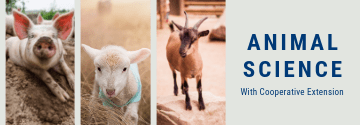Scrapie. A word in the sheep and goat industry that is well known by many, but is truly understood by few. Scrapie is defined as a fatal, degenerative, neurological disease that affects a sheep or goat’s central nervous system. Scientifically, scrapie is classified as a transmissible spongiform encephalopathy or TSE, which is closely related to BSE or Mad Cow disease. The disease itself was first spotted in the United States in 1947 but has been recognized since 1732. Since then, it rapidly spread across the globe, causing massive damage to the sheep and goat industry as a whole. However, with increased awareness and improved management techniques over the years, countries began eradicating the disease from their flocks. Both New Zealand and Australia have successfully eradicated scrapie from their flocks, with the United States attempting to become the third scrapie free country. With scrapie costing the United States sheep industry ten to twenty million dollars annually, it is critical for each breeder to do his or her part in helping the country become scrapie free. In order to eradicate this disease, it is important to understand and become educated on the causes, signs, and prevention of scrapie.
Although still being further investigated by scientist and researchers, an agent that is smaller than a virus and linked to the prion protein is the cause of scrapie. The scrapie agent causes the normal cellular prion protein to become abnormal, causing the cell to grow and replicates at an alarming rate. Scrapie is also highly contagious and can travel from sheep to sheep fairly quickly. Scrapie can be transmitted via bodily fluids of the infected animals, most commonly from an infected ewe or doe to her offspring through the afterbirth or milk. An animal’s genetic make-up also plays an important role in the susceptibility to contracting scrapie with certain DNA characteristics and breeds, such as Suffolk and Hampshire, having higher risks for contracting the disease.
In order to proper defend a flock from scrapie, it is important to be able to recognize an infected animal as soon as possible. Initially, an animal infected with scrapie may appear healthy since scrapie does not begin to take its toll on the animal for two to five years. Scrapie causes several signs and symptoms that can vary animal to animal and can also vary in severity. An animal with scrapie may experience weight loss, behavior changes, tremors, sensitivity to sound or light, or itchiness. More obvious signs include: wool pulling, biting of limbs, hopping on rear legs, inability to stand, or even death. It is critical to be able to recognize these signs and symptoms since a scrapie positive sheep should be immediately removed from the flock to prevent further contamination.
Currently there is no treatment, for the disease is ultimately fatal to any animal that is infected. However, scrapie can be prevented if the proper measures are taken to ensure the safety of the flock. Scrapie is known to have a heat resistant quality and be resistant to standard cleaning practices, making it somewhat difficult to eradicate once present on farm. Regular cleaning of the ground and fences with strong bleach or lye has been proven to kill scrapie. It is also important to ensure that the birthing area is clean, has fresh bedding, and is free of afterbirth. By eliminating places for the scrapie disease organism to lie dormant, the risk of scrapie becomes substantially lower. Another prevention method is to verify that those selling sheep or goats are part of the scrapie certification program and to ensure any sheep bought have proper scrapie tag identification. Throughout the country, each state has taken different precautions to make sure that any scrapie outbreaks can be quickly traced back to the flock of origin and stopped as soon as possible.
In Delaware specifically, all sheep and goats require an official ear tag prior to moving off the premises of origin in order to trace the animal should it contract scrapie. Scrapie tags are thin, usually white, ear tags that include an animal number along with a unique scrapie number specific to a producer’s farm and the US shield. These tags can be easily acquired at any time by calling 1-866-USDA-TAG at no cost to the animal owner and the tags never expire. The National Scrapie Eradication Program will also send those that order scrapie tags a free applicator, making the process easier for producers and eliminating excuses for not following the program.
Many times sheep and goats are often bought and sold to various producers around the country for breeding purposes with can cause some confusion on proper scrapie tag management. If buying sheep or goats with a scrapie tags already in place, then the buyer should leave the original tag in and not replace it with their own. All sheep must have a scrapie tags in place before being sold initially, with the responsibility of this falling on the breeders to perform this action. Finally, scrapie tags should never be shared since they include a number that is specific to one individual producer or farm and would cause confusion should an outbreak occur.
Guest Blog by Hunter Murray, Extension Scholar 2015. Hunter is a lifelong sheep breeder and can be reached at hmurray@udel.edu.
Resources:
FAQ about the scrapie program. USDA. Web. 11 Aug. 2015
Scrapie. Colorado State University Extension. Web. 11 Aug. 2015.
Scrapie fact sheet. National Scrapie Education Initiative. Web. 11 Aug. 2015





